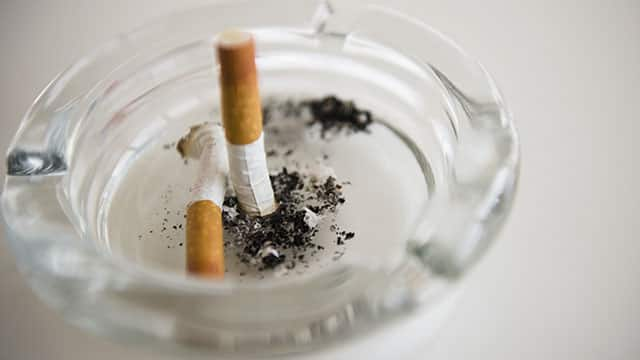Types of Teeth Stains
While a green tooth is rare, tooth discoloration in general is quite common. It is generally divided into two categories, depending on the cause of the staining:
Extrinsic Stains
These stains sit on the surfaces of your teeth and are caused by things you put in your mouth.
- Red wine, tea, coffee, or dark-colored foods like berries can leave stains of all shades on your teeth.
- Prescription mouth rinses used to treat gum disease can leave a dark residue on your teeth.
- Smoking cigarettes or chewing tobacco can stain the teeth a yellow or brown color.
Your oral hygiene habits will have a big impact on the severity of staining. It’s important to brush twice a day and clean between your teeth daily, around 60 minutes after meals if possible. Keep up with regular professional dental hygiene appointments, too. And if you want even whiter teeth, talk to your dental professional about whitening treatments.
Intrinsic Stains
This type of discoloration comes from the inside of your tooth. These are some of the things that may cause intrinsic stains.
- Antibiotics such as tetracycline and liquid amoxicillin
- Trauma to the tooth
- Fluorosis, which is caused by ingesting too much fluoride during early childhood when the tooth enamel is still developing.
- Dead tooth which happens when the pulp of the tooth is damaged and can’t repair itself.
- According to the Cleveland Clinic, aging can affect the color of your teeth. As the enamel thins with age, the darker yellow-ish dentin layer beneath can show through.
- The Cleveland Clinic also notes that radiation and chemotherapy can cause discolored teeth.
Neither good oral hygiene nor professional polishings will remove intrinsic stains. If you have this type of staining and you’d like to improve it, speak to your dentist about cosmetic options like veneers.
What is Green Tooth?
Green tooth is a less common type of intrinsic stain that affects infants. Babies who have jaundice at birth may develop green pigmentation on their baby teeth. According to Allied Academies, this prenatal development type is rare – only about 50 cases a year. Other medical conditions and certain medications can also cause green teeth in babies and young children. In all cases, the primary (baby) teeth will remain green, but they’ll be replaced by normal-colored permanent teeth when the baby teeth fall out.
Why Do Teeth Turn Green in Adults?
Can adults develop green teeth, too? Yes, but most often for different reasons. While green tooth in infants is intrinsic, green tooth in adults is almost always a result of extrinsic factors. Specifically, green tooth is caused by a build-up of stains, bacteria, and fungi resulting from poor oral hygiene and care. Green tooth can also be caused by dark-colored foods and tobacco, although this is unusual; these stains are more likely to be yellow, brown or reddish, depending on the source. Rarely, blood conditions such as hemolytic anemia can cause intrinsic green staining in adult teeth.
Newborn jaundice
Incompatibility between the blood types of pregnant mother and baby
Sepsis
Hemolytic anemia
Certain medications
Extrinsic causes of green tooth
Bacteria
Fungi
Poor oral hygiene
Dark foods and drinks
Tobacco
Who is Most Likely to Experience a Green Tooth?
Babies with jaundice, sepsis, blood disorders, and blood type incompatibility with their mother are at risk of developing green teeth. People with poor oral hygiene are also at risk, as are those who smoke or ingest dark-colored foods and drinks.
How Do You Fix a Green Tooth?
Excluding a medical cause, the best way to fix green teeth is to make improvements to your oral health and lifestyle habits. Brushing your teeth twice a day, and flossing between your teeth every day, can help to lift away stains and stop them from coming back. For extra brightening power, try a whitening toothpaste, as these contain abrasives that can gently scrub away the more stubborn stains. If you use tobacco, quitting will do wonders not just for the color of your teeth, but your overall oral health. And don’t forget to keep up with your regular dental check-ups, as a good professional cleaning can help to keep green stains and other discoloration at bay. If you’ve tried to manage green teeth at home and you’re still seeing staining, ask your dentist about at-home or professional whitening options.
If you want a great smile, make sure your teeth are as white as they can be. Knowing what is causing your enamel discoloration is half the battle. To clean up your smile, improve your oral health regimen, and talk with your dental professional today.
Frequently Asked Questions About Green Tooth
Is it common to have green teeth?
Green teeth are a fairly uncommon type of staining. It’s much more common to have yellow or brown staining due to things like plaque build-up, poor oral hygiene and smoking. Children and adults with certain blood disorders are at greater risk of green teeth.
Is it bad if your teeth are green?
Green teeth are usually the result of poor oral hygiene, an infection or a medical condition. But while green teeth are never good news, they’re not something to panic about, either. Simply book an appointment with your dentist, who can advise you on oral hygiene measures, antimicrobials, or other treatment options.
How long does it take to get rid of green teeth?
That depends on the cause. It is not possible to whiten baby teeth in children that have turned green due to intrinsic causes like newborn jaundice. However, the teeth will eventually fall out and be replaced by natural-colored permanent teeth. For other causes of green teeth, a professional cleaning or an in-office whitening treatment can improve the color of teeth instantly, to varying degrees. Meanwhile, home whitening, oral hygiene, or antimicrobial therapies might take up to a couple of weeks to show improvements.
This article is intended to promote understanding of and knowledge about general oral health topics. It is not intended to be a substitute for professional advice, diagnosis or treatment. Always seek the advice of your dentist or other qualified healthcare provider with any questions you may have regarding a medical condition or treatment.
ORAL HEALTH QUIZ
What's behind your smile?
Take our Oral Health assessment to get the most from your oral care routine
ORAL HEALTH QUIZ
What's behind your smile?
Take our Oral Health assessment to get the most from your oral care routine
Join Us
Get the best of your oral health routine and take it to the next level with expert advice, recommendations, products and solutions and special offers.
Join Us
Get the best of your oral health routine and take it to the next level with expert advice, recommendations, products and solutions and special offers.















